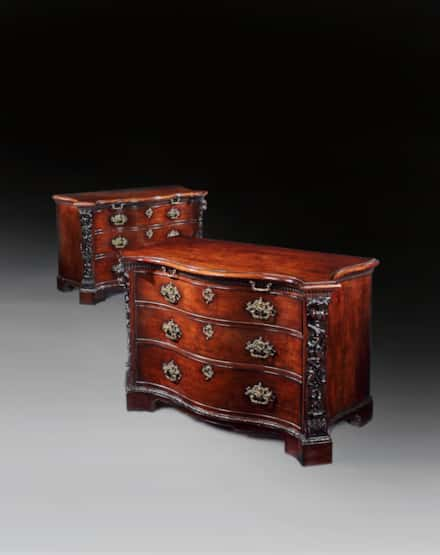A GEORGE I PERIOD SCARLET AND GILT JAPANNED BUREAU CABINET
London, circa 1720
REF1120
An Outstanding George I Period Scarlet and Gilt Japanned Bureau Cabinet
Attributed to John Belchier
London, circa 1720
The upper section with serpentine shaped cornice flanked by two turned finials and centred by a cartouche decorated with a foliate shell. The two mirrored doors decorated with figures, trees and trelliswork opening to reveal an interior with drawers, slides and pigeonholes. The lower section with fall, decorated with exotic scenes of villages on islands linked by a bridge with houses, figures and birds, with a border of trelliswork and floral sprays, opening to reveal a stepped interior with drawers and pigeonholes and a slide over a concealed well. The two short and two long drawers, similarly, decorated with figures in a landscape with villages and Rocky Mountains. The bureau raised upon bracket and turned feet. The cabinet has survived in a remarkable state of preservation, retaining all its original brass handles, escutcheons and even its original key.
Height: 102 inches (260 cm), Width: 40 1/2 inches (102.5 cm), Depth: 24 1/2 inches (62 cm)
PROVENANCE
Private collection, Monte Carlo
DESCRIPTION
This cabinet’s exceptional quality, distinctive form and idiosyncratic decorative details, suggest an attribution to famed London cabinet-maker John Belchier (d. 1753). Belchier’s authorship is based on comparisons to similar examples, such as the two supplied to Erddig Castle in Wales. The Erddig cabinets were described in 1732 as being ‘in ye grandest manner and after ye newest fashion’.
John Belchier (fl. 1717–1753) was a prominent English cabinetmaker associated with the celebrated St. Paul’s Churchyard, a hub of fine furniture production in early Georgian London. He was known for supplying furniture to the aristocracy and institutions like Oxford and Cambridge colleges. Belchier’s name is most often associated with refined craftsmanship and a willingness to embrace both traditional and contemporary styles.
One of his most distinctive contributions to 18th-century decorative arts was his japanned bureau cabinets. Japanning—an English interpretation of Asian lacquer work—involved layers of varnish, often black or red, decorated with chinoiserie motifs in gold and other colours. Belchier’s japanned cabinets stood out for their rich surface decoration, elegant proportions, and restrained yet luxurious detailing.
These cabinets typically featured a sloped writing surface, drawers below, and an upper cabinet with doors enclosing shelves and small drawers—often with mirrored interiors or architectural elements such as columned niches. The japanning not only reflected the period’s fascination with the exotic East but also demonstrated Belchier’s commitment to high-quality, fashionable goods tailored to elite tastes.
Surviving examples of Belchier’s japanned bureau cabinets are rare and highly prized, embodying the opulence, craftsmanship, and global influences that defined English furniture during the early 18th century.
The lacquered furniture imported to Europe by the East India Company in the late 17th century sparked a demand for larger, more functional pieces that emulated the vibrant and ornate surfaces of their Eastern originals. To replicate the rich appearance of oriental lacquerware, European cabinetmakers turned to John Stalker and George Parker’s 1688 publication A Treatise of Japanning and Varnishing. This influential manual quickly became an essential reference, offering not only instructions for achieving a variety of colours but also adaptable designs featuring Chinese figures, flora, and garden scenes.
YOU MAY ALSO LIKE
A GEORGE I PERIOD SCARLET AND GILT JAPANNED BUREAU CABINET




 PRINT
PRINT SHARE
SHARE


